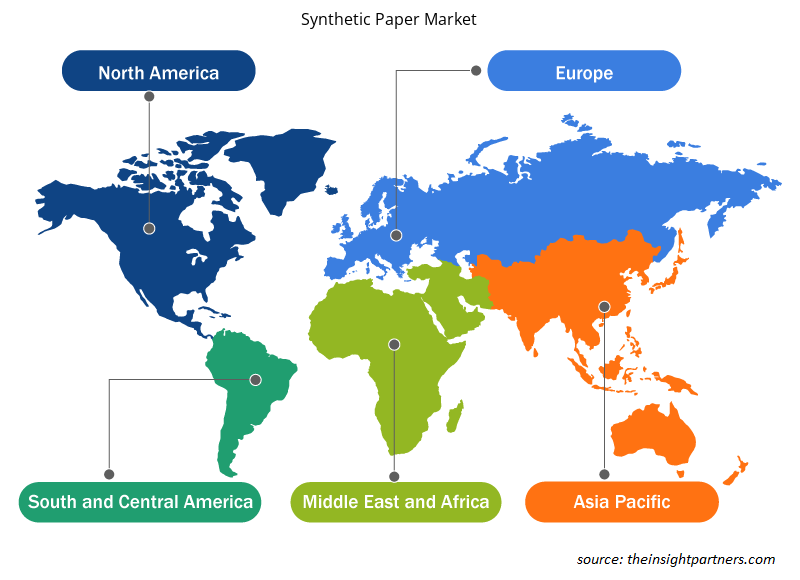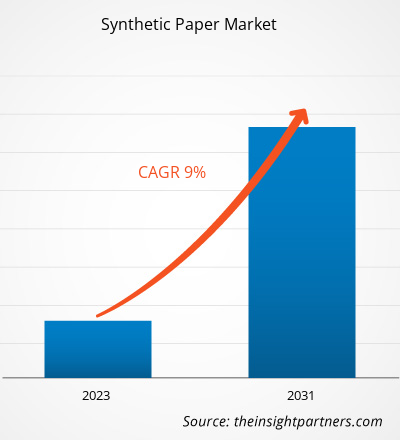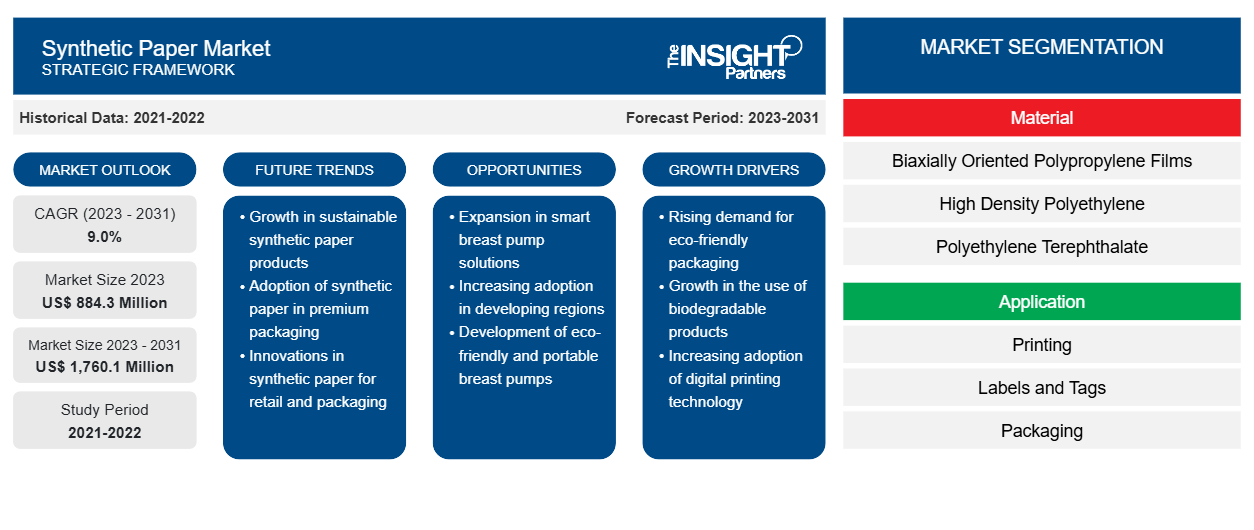Se proyecta que el tamaño del mercado de papel sintético alcance los 1.760,1 millones de dólares estadounidenses en 2031, frente a los 884,3 millones de dólares estadounidenses en 2023. Se espera que el mercado registre una CAGR del 9,0 % entre 2023 y 2031. Es probable que la creciente demanda de las industrias de embalaje e impresión siga siendo una tendencia clave del mercado de papel sintético.
Análisis del mercado del papel sintético
La demanda de papel sintético en la industria del embalaje está creciendo debido a su durabilidad superior y sus beneficios ambientales. A diferencia del papel tradicional, el papel sintético es altamente resistente al agua, a los productos químicos y al desgarro, lo que lo convierte en una opción ideal para los embalajes que deben soportar condiciones duras durante el transporte y el almacenamiento. Esta durabilidad garantiza que el embalaje permanezca intacto y legible, preservando la integridad del producto y mejorando la satisfacción del cliente. Además, la resistencia del papel sintético a los factores externos reduce significativamente el riesgo de daños, lo que genera ahorros de costos en los reemplazos de embalajes y mejora la eficiencia general de la cadena de suministro.
Descripción general del mercado del papel sintético
El mercado del papel sintético está experimentando una importante combinación impulsada por el crecimiento de sus propiedades materiales únicas, beneficios ambientales y aplicaciones en expansión en varias industrias. Su resistencia al desgarro, al agua, a los productos químicos y a las temperaturas extremas hace que el papel sintético sea ideal para aplicaciones donde la longevidad y la resiliencia son cruciales. Esto es particularmente beneficioso en sectores como la impresión, el etiquetado y la publicidad exterior , donde los materiales a menudo están expuestos a condiciones duras. Por ejemplo, las instituciones educativas y las empresas valoran el papel sintético para producir manuales y materiales promocionales duraderos, mientras que los anunciantes exteriores confían en su capacidad para mantener colores vibrantes e integridad estructural bajo estrés climático.
Personalice este informe según sus necesidades
Obtendrá personalización en cualquier informe, sin cargo, incluidas partes de este informe o análisis a nivel de país, paquete de datos de Excel, así como también grandes ofertas y descuentos para empresas emergentes y universidades.
- Obtenga las principales tendencias clave del mercado de este informe.Esta muestra GRATUITA incluirá análisis de datos, desde tendencias del mercado hasta estimaciones y pronósticos.
Factores impulsores y oportunidades del mercado del papel sintético
La creciente demanda de la industria del embalaje impulsa el crecimiento del mercado del papel sintético
La creciente demanda de la industria de la impresión es un importante impulsor del mercado, impulsado por la necesidad de materiales impresos duraderos y de alta calidad. A diferencia del papel tradicional, el papel sintético permite colores vibrantes e imágenes nítidas, que son esenciales para crear productos impresos visualmente atractivos y de aspecto profesional. Esta alta calidad de impresión es particularmente importante para materiales promocionales, folletos, tarjetas de presentación y otros materiales de marketing donde las primeras impresiones importan. A medida que las empresas buscan mejorar sus esfuerzos de marca y comunicación, la capacidad de producir impresiones de alta resolución y estéticamente agradables en papel sintético es una gran ventaja. La durabilidad es otro factor crucial que impulsa la demanda de papel sintético en la industria de la impresión. Los materiales impresos a menudo deben soportar una manipulación frecuente, la exposición a la humedad y otras condiciones difíciles sin degradarse. La resistencia del papel sintético al desgarro, al agua y a los productos químicos garantiza que los documentos impresos permanezcan intactos y legibles con el tiempo. Esto es especialmente valioso para productos como menús, manuales, mapas y materiales educativos que están sujetos a un uso intensivo. La durabilidad del papel sintético reduce la necesidad de reemplazos frecuentes, lo que genera ahorros de costos para las empresas e instituciones que dependen de materiales impresos. Esta calidad duradera hace que el papel sintético sea la opción preferida para muchas aplicaciones de impresión.
Mayor atención a la sostenibilidad medioambiental
La creciente atención a la sostenibilidad medioambiental es un importante impulsor de la demanda de papel sintético, ya que las empresas y los consumidores son cada vez más conscientes de su huella ecológica. A diferencia del papel tradicional, que implica deforestación y un alto consumo de agua durante su producción, el papel sintético está hecho de polipropileno o polietileno, que son totalmente reciclables. Esto significa que el papel sintético se puede reprocesar y reutilizar, lo que reduce los residuos y conserva los recursos naturales. Las empresas que buscan mejorar sus prácticas de sostenibilidad optan cada vez más por el papel sintético para alinearse con sus objetivos medioambientales, impulsando así el crecimiento del mercado.
Informe de mercado de papel sintético Análisis de segmentación
Los segmentos clave que contribuyeron a la derivación del análisis del mercado de papel sintético son el material y la aplicación.
- Según el material, el mercado se segmenta en películas de polipropileno orientado biaxialmente (BOPP), polietileno de alta densidad (HDPE), tereftalato de polietileno (PET), cloruro de polivinilo (PVC) y otros. El segmento de películas de polipropileno orientado biaxialmente (BOPP) tuvo una mayor participación de mercado en 2023.
- En términos de aplicación, el mercado está segmentado en impresión, etiquetas y rótulos, embalajes y otros. El segmento de impresión tuvo la mayor participación del mercado en 2023.
Análisis de la cuota de mercado del papel sintético por geografía
El alcance geográfico del informe del mercado de papel sintético se divide principalmente en cinco regiones: América del Norte, Asia Pacífico, Europa, Medio Oriente y África, y América del Sur y Central.
La región de Asia Pacífico está experimentando un crecimiento significativo debido a una combinación de crecimiento económico, expansión industrial y creciente demanda de materiales duraderos y de alta calidad. La sólida base industrial en China, Japón e India es un factor significativo que impulsa el crecimiento del mercado. Estos países se han establecido como potencias manufactureras, produciendo una amplia gama de bienes que requieren soluciones de etiquetado, embalaje e impresión confiables y duraderas . El papel sintético, con su resistencia superior al desgarro, la humedad y los productos químicos, satisface estas necesidades, impulsando efectivamente una demanda significativa en el sector industrial. Además, la urbanización y el aumento de los ingresos disponibles han llevado a un mayor consumo de bienes de consumo, lo que a su vez impulsa la demanda de soluciones de embalaje avanzadas. El comercio electrónico, que ha experimentado un crecimiento explosivo en la región, amplifica aún más esta necesidad. El papel sintético es muy valorado en el embalaje por su integridad y apariencia en diversas condiciones, lo que lo convierte en una opción ideal para fines minoristas y de envío. La durabilidad y la calidad de impresión del papel sintético mejoran la presentación del producto y la visibilidad de la marca, lo que es crucial en un mercado competitivo.
Perspectivas regionales del mercado del papel sintético
Los analistas de Insight Partners explicaron en detalle las tendencias y los factores regionales que influyen en el mercado del papel sintético durante el período de pronóstico. Esta sección también analiza los segmentos y la geografía del mercado del papel sintético en América del Norte, Europa, Asia Pacífico, Oriente Medio y África, y América del Sur y Central.

- Obtenga los datos regionales específicos para el mercado de papel sintético
Alcance del informe sobre el mercado del papel sintético
| Atributo del informe | Detalles |
|---|---|
| Tamaño del mercado en 2023 | US$ 884,3 millones |
| Tamaño del mercado en 2031 | US$ 1.760,1 millones |
| CAGR global (2023 - 2031) | 9.0% |
| Datos históricos | 2021-2022 |
| Período de pronóstico | 2023-2031 |
| Segmentos cubiertos | Por material
|
| Regiones y países cubiertos | América del norte
|
| Líderes del mercado y perfiles de empresas clave |
|
Densidad de actores del mercado del papel sintético: comprensión de su impacto en la dinámica empresarial
El mercado del papel sintético está creciendo rápidamente, impulsado por la creciente demanda de los usuarios finales debido a factores como la evolución de las preferencias de los consumidores, los avances tecnológicos y una mayor conciencia de los beneficios del producto. A medida que aumenta la demanda, las empresas amplían sus ofertas, innovan para satisfacer las necesidades de los consumidores y aprovechan las tendencias emergentes, lo que impulsa aún más el crecimiento del mercado.
La densidad de actores del mercado se refiere a la distribución de las empresas o firmas que operan dentro de un mercado o industria en particular. Indica cuántos competidores (actores del mercado) están presentes en un espacio de mercado determinado en relación con su tamaño o valor total de mercado.
Las principales empresas que operan en el mercado del papel sintético son:
- Películas Cosmo Ltd.
- NAGASE (EUROPA) GmbH
- Materiales de embalaje IPP
- Arjobex SAS
- Industrias PPG, Inc.
- Corporación Avery Dennison
Descargo de responsabilidad : Las empresas enumeradas anteriormente no están clasificadas en ningún orden particular.

- Obtenga una descripción general de los principales actores clave del mercado de papel sintético
Noticias y desarrollos recientes del mercado del papel sintético
El mercado del papel sintético se evalúa mediante la recopilación de datos cualitativos y cuantitativos a partir de investigaciones primarias y secundarias, que incluyen publicaciones corporativas importantes, datos de asociaciones y bases de datos. A continuación, se incluye una lista de los avances en el mercado del papel sintético y las estrategias:
- Hoy, Agfa anuncia el lanzamiento al mercado de su papel sintético SYNAPS Xerographic Matt (XM), que incluye un agente que antagoniza la instalación y el crecimiento de bacterias y virus en su superficie. El agente permanece activo durante toda la vida útil del papel sintético y protege también las áreas de impresión cubiertas con tinta de tóner. Su eficiencia de hasta el 99,99 % ha sido demostrada mediante pruebas independientes ISO 20743 e ISO 18184. Este nuevo tipo de SYNAPS XM reemplaza la gama de productos XM existente al tiempo que conserva por completo su excelente calidad de impresión, comportamiento de proceso antiestático y compatibilidad universal con impresoras. (Fuente: Grupo Agfa-Gevaert, Nota de prensa, 2021)
Informe sobre el mercado del papel sintético: cobertura y resultados
El informe "Tamaño y pronóstico del mercado de papel sintético (2021-2031)" proporciona un análisis detallado del mercado que cubre las siguientes áreas:
- Tamaño del mercado y pronóstico a nivel global, regional y nacional para todos los segmentos clave del mercado cubiertos bajo el alcance
- Dinámica del mercado, como impulsores, restricciones y oportunidades clave
- Principales tendencias futuras
- Análisis detallado de las cinco fuerzas de Porter y FODA
- Análisis del mercado global y regional que cubre las tendencias clave del mercado, los principales actores, las regulaciones y los desarrollos recientes del mercado.
- Análisis del panorama de la industria y de la competencia que abarca la concentración del mercado, el análisis de mapas de calor, los actores destacados y los desarrollos recientes
- Perfiles detallados de empresas
- Análisis histórico (2 años), año base, pronóstico (7 años) con CAGR
- Análisis PEST y FODA
- Tamaño del mercado, valor/volumen: global, regional y nacional
- Industria y panorama competitivo
- Conjunto de datos de Excel
Informes recientes
Informes relacionados
Testimonios
Razón para comprar
- Toma de decisiones informada
- Comprensión de la dinámica del mercado
- Análisis competitivo
- Información sobre clientes
- Pronósticos del mercado
- Mitigación de riesgos
- Planificación estratégica
- Justificación de la inversión
- Identificación de mercados emergentes
- Mejora de las estrategias de marketing
- Impulso de la eficiencia operativa
- Alineación con las tendencias regulatorias





















 Obtenga una muestra gratuita para - Mercado de papel sintético
Obtenga una muestra gratuita para - Mercado de papel sintético